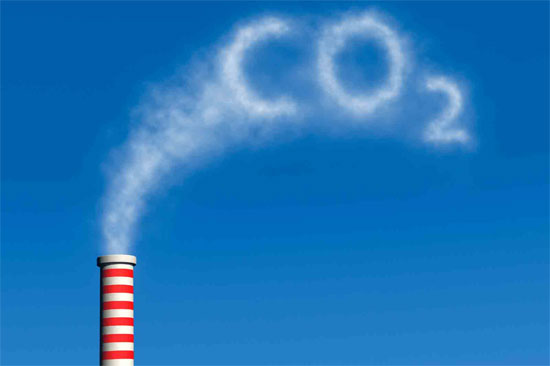Japan conducts 'burying' CO2 on the seabed
The Ministry of Environment of Japan on September 5 said that from the spring of 2014, specific location options in the submarine stratum will be carried out to implement a plan to 'bury' a large amount of CO2 recovered from power plants.
>>>CO2 capture technology is not commonly used
This is seen as a way to cope with increasing CO2 emissions as Japan has to use thermal power plants since the tsunami disaster in March 2011, causing all of the Japan's nuclear power plant must be temporarily suspended.
The increase in CO 2 makes Japanese experts determine the collection and burial of this gas underground will be an effective solution in accordance with the policy to cope with the greenhouse effect that the government is advancing. onions. As expected, the implementation of the project to bury CO 2 will be carried out until 2030.
The Japan Environment Ministry report said the survey will focus on three areas below the 200m depth of the ocean, allowing millions of tons of CO2 to be buried each year.
Japanese seabed areas are now considered to be used for many different purposes, so the prospect of implementing the CO2 storage plan is very feasible. However, to be able to confirm what layer of storage is required requires a comprehensive and long-term research process.

Photo: surfriderasturias.wordpress.com
The report also said that the process of burying carbon dioxide into the geological area on the ocean floor requires careful handling of this type of emissions at thermal power plants. Therefore, the construction of a tens of kilometers transport pipeline to the bays and the coast may not be suitable, instead experts are studying transport and storage systems using transports.
As expected, the test of the transport vessel for this process will be carried out in 2016, in which experts will apply the technology to pack CO2 from ships and offshore rigs, then Put it to the sea floor.
Japan's Ministry of the Environment said funding for technology investigation, exploration and testing activities in fiscal year 2014 will be about 1.2 billion yen.
Japan 's Environmental Industry Technical Research Agency said the ability to bury CO2 in waters near Japan is about 150 billion tons. The amount of greenhouse gas in Japan in 2011 was 1.3 billion tons, equivalent to the amount of Japanese gas released during the past 120 years.
The agency also said that the ability to store seabed CO2 in the world is about 10 trillion tons, and competition between rivals from the US and Europe in researching and conducting gas burial This waste will be getting bigger and bigger.
The Japanese Ministry of Economy, Science and Industry also said that the trial of underground burial of CO2 on Japanese territory will start from 2016, with reserves of about 200 tons / year.
Meanwhile, the Ministry of Environment of Japan said that through this experiment, the application of technology and technology will be supplemented for the research process affecting the surrounding waters and the possibility of gas leakage CO 2 will be carried out.
After the disaster of the Fukushima 1 nuclear power plant in 2011, Japan had to shut down nuclear power plants that did not emit carbon dioxide. In 2012, 90% of Japan's electricity is produced from thermal power plants, leading to a rapid increase in greenhouse gas emissions.
The restart of Japanese nuclear power plants has been carried out, but the use of thermal power plants remains unchanged, so dealing with CO2 is an urgent task of the government. Tokyo.
If the burying of CO 2 below ground is deployed, the chances of opening a Japanese high-efficiency thermal power plant abroad are huge.
- Seabed survey in the earthquake area in Japan
- Japan exploits natural gas from burnt ice
- Japan drill to prepare to exploit gas in the seabed
- Japan is about to exploit gas from
- Canada started drawing seabed maps around the North Pole
- The burial of the dead in the pottery of ancient Egypt
- The Japanese seabed moved 24 m because of the earthquake
- Japan plans to bury the reactors
- Seabeds on the oceans are literally melted and what is the reason?
- Found Samurai underground aircraft aviation
- Lake the giant ghost under the Pacific Ocean
- Japan: Turn CO2 into natural gas
 Is the magnetic North Pole shift dangerous to humanity?
Is the magnetic North Pole shift dangerous to humanity? Washington legalizes the recycling of human bodies into fertilizer
Washington legalizes the recycling of human bodies into fertilizer Lightning stone - the mysterious guest
Lightning stone - the mysterious guest Stunned by the mysterious sunset, strange appearance
Stunned by the mysterious sunset, strange appearance Interesting things only in Japan
Interesting things only in Japan  Why are Japanese people less obese?
Why are Japanese people less obese?  How did the Shinkansen bullet train change the world?
How did the Shinkansen bullet train change the world?  Poor people in Nepal changed their lives by providing Japanese shrubs to make paper for printing money
Poor people in Nepal changed their lives by providing Japanese shrubs to make paper for printing money  The bird flu epidemic was so bad that Japan ran out of land to bury chickens
The bird flu epidemic was so bad that Japan ran out of land to bury chickens  Japan's world champion anti-flood underground construction: Each tank can hold 1 space shuttle
Japan's world champion anti-flood underground construction: Each tank can hold 1 space shuttle 